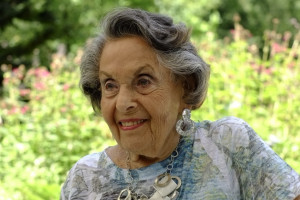
In the 1960s, most American women would have readily agreed that passion, courage, drive and vision are qualities necessary for a successful career. However, they would probably be considering their husband or father’s career. Even as feminists like Betty Friedan and Gloria Steinem were thinking and writing outside the bounds of patriarchy, the majority of American women faced conventional expectations: marriage, children and a life of caretaking. One Moore alumna, Dr. Myra Levick '63, defied those expectations to become a pioneer in the seminal field of art therapy. Levick, who died in 2020 at the age of 96, was the founding director of graduate art therapy at Hahnemann Medical College and Hospital (now Drexel University) and a co-founder and first president of the American Art Therapy Association (AATA).
"I feel honored to have had Myra as a teacher and mentor," said Dr. Marcia Taylor '70. "Her influence over the past 50 years is apparent to me as I reflect on my work with children, adults and incarcerated individuals serving life sentences. Her passionate belief in the therapeutic power of the arts, especially visual arts, encouraged me to pursue a doctorate in behavioral science."
Myra Levick seemed to be headed on the conventional path when she married her high school sweetheart, Leonard Levick, at age 19 and started a family in their hometown of Philadelphia. However, not only did Myra possess all the above qualities described as necessary for a successful career, she wanted a career. The couple agreed that she would take care of their three daughters and support him while in medical school and during his internship if he would then support her through college.
Levick chose to study painting and graduated from Moore College of Art & Design in 1963 with a BFA. She was set to earn an MA in art history at Bryn Mawr College but impulsively chose to answer an ad placed by Dr. Morris Goldman at Albert Einstein Medical Center. Dr. Goldman, director of an open psychiatric unit, was searching for an artist to explore art therapy with patients and Myra was interested. When Goldman was hired by Hahnemann Hospital and Medical College in 1966, she went with him. Goldman and Levick’s shared vision was to combine traditional therapies with creative methods of expression—visual art, music and dance—in order to foster psychological healing. In 1967, the two launched an undergraduate program in art therapy, dually hosted by Hahnemann Medical College and Moore. In 1970, the first graduate-level art therapy program in the U.S. was established at Hahnemann.
"From those early years there was excitement about the new formalized course of study," said Taylor. "I enrolled at Hahnemann in 1970 and received my master's in art therapy in 1972. One of the memorable experiences from my internship placements was every Monday in a therapeutic nursery school setting where Dr. Levick's daughter Bonnie was the head teacher. Under her guidance and with Myra's mentoring I taught a 15-minute art lesson to mainly 3-year-olds It was a true challenge keeping that little special population engaged!"
EFFECTIVE LEADERSHIP
Levick was pioneering a new field in a profession dominated by men. Women professors were almost nonexistent. When Dr. Goldman died unexpectedly at age 39, the graduate school promoted Levick to assistant professor and named her director of the program. She was a strong advocate for professionalization and helped to establish the American Art Therapy Association in 1969, becoming the organization’s first president. In a memorial tribute published by the AATA, Levick’s colleagues testified that her “eloquence, pragmatism and brilliance” determined her effective leadership.
Levick earned a MEd in adolescent psychology from Temple University and a PhD in education and child development from Bryn Mawr College. In 1980, she spent five weeks working under Anna Freud in Hampstead, England. The research she did in child development and psychodynamics under Freud became the basis for her dissertation, published in 1983 as a textbook in art therapy. Levick went on to write several books on different aspects of art therapy and to write and edit numerous articles. She served as editor in chief of Arts in Psychotherapy from 1981–1985. Working with Janet Bush, the two therapists researched, developed and implemented trials for an assessment tool that was published as the Levick Emotional and Cognitive Art Therapy Assessment.
PIONEERING CAREER
Retirement to Boca Raton, FL, in 1986 meant working to establish the South Florida Art Psychotherapy Institute, an agency offering consultation, supervision and lectures. She served as a consultant for the art therapy program for Miami-Dade County, the fourth-largest school district in the United States. Levick continued to work as an art therapist in Florida, providing therapy to recovering substance abusers, incest survivors and Alzheimer’s patients. She also continued to teach psychology and child development courses. Somehow, Levick always found time to paint and draw and exhibited her work with the local branch of the National League of American Pen Women, where she had dual membership in arts and letters and also served as president.
At age 93, a true pioneer, Levick took on yet another challenge: ageism and the invisibility of seniors. Dear Myra, Dear Max: A Conversation About Aging, published in 2017, contains four years of email conversations exchanged with her colleague and friend, Dr. Maxine Borowsky Junge, exploring the aging process and the role of older women in society. The book cover depicts a flourishing tree painted by Levick.
“She was a feminist before there was feminism,” according to Bonnie Cossrow, one of Myra’s three daughters. They all agreed, she didn’t always make it to the school play, but "we understood the courage of her choices, the brilliance of her mind, and the priceless gift of leadership, power and equality that she bestowed on us.” Alumni of Moore College of Art & Design can be equally proud and inspired by the example of Dr. Myra Levick and her pioneering career.
